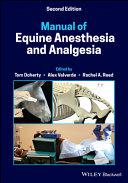Manual of Equine Anesthesia and Analgesia, 2nd Edition

Plně aktualizované nové vydání praktického průvodce anestezie u koní a jiných koňovitých, poskytující aktualizované a rozšířené informace ve stručném a snadno čitelném formátu nejen pro praktiky, ale i studenty veterinární medicíny. Manuál obsahuje stručné a praktické pokyny pro zvládnutí anestezie koní, oslů a mezků. Graficky je koncipována jako referenční manuál a zdroj informací o základních fyziologických a farmakologických principech anestezie, přípravy a monitorování pacienta a řízení sedace a anestezie. Kapitoly sepsali přední veterinární anesteziologové a obsahují kvalitní obrázky a ilustrace klinických případů, tabulky, diagramy a shrnutí důležitých bodů v rámečcích.
Druhé vydání bylo rozsáhle revidováno, barevně ilustrován a doplněno o aktuální informace. Nově jsou uvedeny informace o terapii koní podstupujících MRI vyšetření, ventilátorech, blokádách nervů při reprodukční chirurgii, myorelaxanciích, různých nových preparátech, paravertebralní anestézii, využití akupunktury při léčbě bolestí, o technikách rehabilitace a další. Aktuální přílohy obsahují seznamy a dávkování léků a také rovnice týkající se kardiovaskulárního a respiračního systému koní. Manuál je nezbytným zdrojem informací pro všechny praktické lékaře a veterinární studenty zabývající se anestezií koňovitých pacientů.
Tento stručný a snadno pochopitelný průvodce:
Poskytuje praktické, klinicky orientované informace o anesteziologických prostředcích.
Používá formát s odrážkami navržený pro rychlý přístup ke klíčovým informacím.
Nabízí podrobné pokyny a schémata blokády nervů na končetinách, hlavě a očních strukturách.
Zahrnuje nová poznatky o regulaci extracelulární tekutiny a krevního tlaku, acidobazických poruch a hemodynamických účinků autonomních léků.
Autor: Tom Doherty (Editor), Alexander Valverde (Editor), Rachel A Reed (Editor)
| Nakladatel | Wiley-Blackwell |
|---|---|
| ISBN | 9781119631286 |
| Vydání | II. vydání 2022 |
| Vazba | brožovaná |
| Počet stran | 720 |
A fully updated new edition of this practical guide to managing anesthesia in horses and other equids, providing updated and expanded information in a concise, easy-to-read format
»Manual of Equine Anesthesia and Analgesia« provides practitioners and veterinary students with concise, highly practical guidance to anesthetizing horses, donkeys, and mules. Using a bulleted quick-reference format, this popular resource covers the basic physiological and pharmacological principles of anesthesia, patient preparation and monitoring, and the management of sedation and anesthesia. Chapters written by leading veterinary anesthesiologists contain numerous clinical images and illustrations, case examples, tables, diagrams, and boxed summaries of important points.
Now in full color, the second edition features extensively revised and updated information throughout. New sections cover chronic pain, management of horses undergoing MRI, ventilators, nerve blocks for reproductive surgery, muscle relaxants, various new drugs, paravertebral anesthesia, treatment of pain using acupuncture and physical rehabilitation techniques, and more. Up-to-date appendices contain drug lists and dosages as well as equations related to equine cardiovascular and respiratory systems.
This concise, easy-to-follow guide:
Provides practical, clinically oriented information on anesthetizing equids
Uses a bulleted format designed for fast access of key information
Offers step-by-step instructions and diagrams of nerve blocks of the limbs, head, and ophthalmic structures
Includes new coverage of topics including regulation of extracellular fluid and blood pressure, acid-base disorders, and hemodynamic effects of autonomic drugs
»Manual of Equine Anesthesia and Analgesia«, Second Edition, remains a must-have resource for all equine practitioners and veterinary students involved with anesthetizing horses.